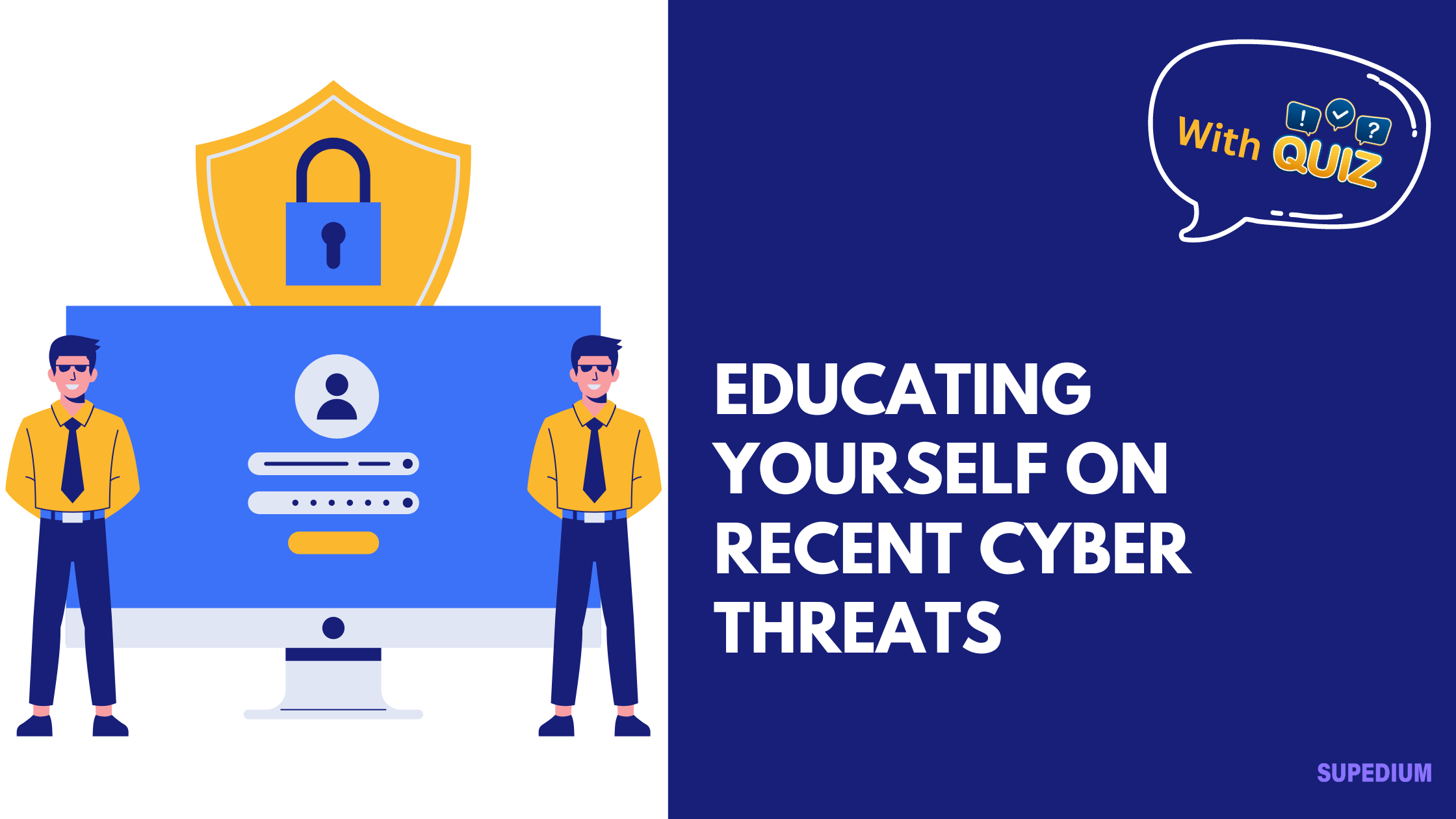Table of Contents
![]()
In today’s digital age, staying informed about cyber threats is crucial for safeguarding personal and organizational security. Cyber threats continue to evolve rapidly, with new tactics and technologies emerging regularly. Understanding these threats and keeping up-to-date with the latest information is essential for effective defense and mitigation strategies. This article provides a comprehensive guide on recent cyber threats, sources of information, and practical steps for education and awareness.
I. Introduction
A. Definition of Cyber Threats
Cyber threats refer to potential malicious activities aimed at compromising the integrity, confidentiality, or availability of information systems. These threats can manifest in various forms, including cyberattacks, vulnerabilities, and malicious activities. Unlike general cyberattacks that are actions taken against a system, cyber threats encompass the broader spectrum of potential risks and adversaries.
B. Importance of Staying Informed
As cyber threats grow more sophisticated, staying informed is vital. Knowledge of emerging threats helps individuals and organizations preemptively address vulnerabilities and improve security measures. Awareness of recent threats also aids in understanding the tactics employed by threat actors, allowing for better preparedness and response strategies.
II. Understanding Recent Cyber Threats
A. Overview of Recent Trends
Recent trends indicate an increase in the complexity and scale of cyber threats. Threat actors, including nation-states and organized cybercriminal groups, have advanced their methods, making it crucial to stay updated on the latest threat vectors and attack strategies.
B. Categories of Recent Cyber Threats
- MalwareMalware, or malicious software, continues to be a significant threat. Recent developments include:
- Ransomware: This type of malware encrypts data and demands a ransom for decryption. High-profile ransomware attacks, such as those targeting critical infrastructure, have highlighted its growing severity.
- Spyware: Designed to monitor and collect information from infected devices, spyware has become more advanced, with capabilities to exfiltrate sensitive data without detection.
- Trojans: These deceptive programs disguise themselves as legitimate software but carry out malicious activities once installed. Recent examples demonstrate increasingly sophisticated methods of infiltration and persistence.
- Phishing and Social EngineeringPhishing attacks, which deceive users into divulging sensitive information, have evolved:
- Spear Phishing: Tailored to specific individuals or organizations, spear phishing attacks use personalized information to increase credibility and success rates.
- Business Email Compromise (BEC): Attackers use spoofed emails to impersonate executives or trusted contacts, often leading to significant financial losses or data breaches.
- Network AttacksNetwork attacks exploit vulnerabilities in network protocols and infrastructure:
- Distributed Denial of Service (DDoS) Attacks: These attacks overwhelm networks or services with excessive traffic, causing disruptions and outages. Recent DDoS attacks have demonstrated increased scale and sophistication.
- Exploits: Vulnerabilities in network protocols, such as those used for remote access or data transmission, are frequently targeted by attackers seeking unauthorized access or data breaches.
- Data Breaches and LeaksData breaches, involving unauthorized access to sensitive data, remain a critical concern:
- High-Profile Breaches: Recent incidents, such as breaches affecting large corporations or government entities, have exposed millions of records and underscored the need for robust security measures.
- Trends in Data Theft: Attackers are increasingly targeting valuable personal and financial information, leveraging it for identity theft, financial fraud, or blackmail.
- Insider ThreatsInsider threats arise from individuals within an organization who misuse their access:
- Malicious Insiders: Employees or contractors who intentionally cause harm or steal data for personal gain or to damage the organization.
- Challenges in Detection: Insider threats are difficult to detect due to the legitimate access insiders have. Monitoring and behavioral analytics play a crucial role in identifying suspicious activities.
III. Sources of Information
A. Cybersecurity News and Alerts
Staying informed through reliable sources is key:
- Industry News Websites and Blogs: Websites such as Krebs on Security, The Hacker News, and Dark Reading provide timely updates on emerging threats and trends.
- Government and Regulatory Alerts: Agencies like the Cybersecurity and Infrastructure Security Agency (CISA) and the National Institute of Standards and Technology (NIST) issue alerts and guidelines on new threats and best practices.
B. Threat Intelligence Platforms
Threat intelligence platforms offer valuable insights:
- Commercial Services: Providers such as CrowdStrike and FireEye offer in-depth analysis and real-time threat intelligence to help organizations defend against advanced threats.
- Open-Source Intelligence (OSINT) Tools: Tools like Shodan and VirusTotal provide publicly available information and resources for threat detection and analysis.
C. Research Papers and Reports
Academic and industry research contribute to understanding cyber threats:
- Academic Research: Universities and research institutions publish studies on new attack vectors and cybersecurity techniques.
- Cybersecurity Firm Reports: Companies like Symantec and McAfee release annual reports detailing trends, statistics, and case studies on cyber threats.
D. Cybersecurity Conferences and Webinars
Attending conferences and webinars enhances knowledge and networking:
- Major Events: Conferences such as Black Hat and DEF CON feature presentations on the latest research and developments in cybersecurity.
- Webinars: Online seminars provide accessible learning opportunities and updates on emerging threats and defensive strategies.
IV. Tools and Resources for Staying Updated
A. Threat Intelligence Feeds
Subscribing to threat intelligence feeds keeps you informed:
- Subscription-Based Feeds: Services such as AlienVault and Recorded Future provide curated threat intelligence and analysis.
- Free Feeds: Open-source feeds, like those from the Open Threat Exchange (OTX), offer valuable information at no cost.
B. Security Blogs and Forums
Engaging with the cybersecurity community helps with learning and sharing:
- Popular Blogs: Blogs like Schneier on Security and SANS Internet Storm Center offer expert insights and analysis.
- Online Forums: Platforms like Reddit’s r/netsec and Stack Exchange’s Information Security community facilitate discussions and knowledge sharing.
C. Social Media and Professional Networks
Following experts and engaging with professional networks:
- Social Media: Platforms like Twitter and LinkedIn are useful for following cybersecurity experts, organizations, and real-time updates.
- Professional Networks: Joining groups and associations, such as ISACA or (ISC)², offers access to a network of professionals and additional resources.
V. Practical Steps for Education and Awareness
A. Regular Training and Education
Ongoing education is essential for staying current:
- Online Courses and Certifications: Platforms like Coursera and Udemy offer courses on cybersecurity fundamentals and advanced topics. Certifications from organizations like CompTIA and (ISC)² validate expertise and knowledge.
- In-House Training Programs: Organizations should implement regular training sessions and workshops to keep employees informed about current threats and best practices.
B. Simulating Cyber Attack Scenarios
Testing response capabilities through simulations:
- Tabletop Exercises: These involve scenario-based discussions to test and improve response strategies and decision-making processes.
- Penetration Testing and Red Teaming: Engaging external experts to simulate attacks helps identify vulnerabilities and assess the effectiveness of security measures.
C. Implementing Best Practices
Adopting security best practices mitigates risks:
- Strong Password Policies and Multi-Factor Authentication (MFA): Enforcing complex password requirements and using MFA adds layers of security.
- Regular Software Updates and Patch Management: Keeping systems and applications updated helps protect against known vulnerabilities.
D. Encouraging a Security-Aware Culture
Promoting a culture of security awareness within organizations:
- Security Awareness Programs: Implementing ongoing awareness programs ensures that employees understand and adhere to security policies and practices.
- Continuous Learning: Fostering an environment where learning and adaptation to new threats are encouraged enhances overall security posture.
VI. Conclusion
In conclusion, staying informed about recent cyber threats is crucial for effective cybersecurity. By understanding the evolving threat landscape, leveraging reliable sources of information, and adopting best practices for education and awareness, individuals and organizations can better protect themselves against cyber threats. Continuous learning and vigilance are essential in the ever-changing realm of cybersecurity.






Be the first to comment